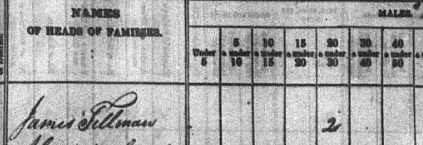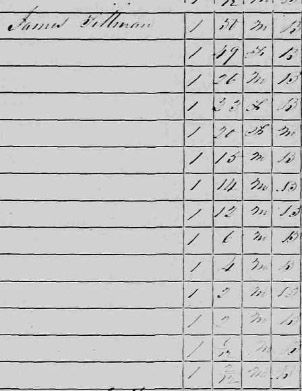- map
- how you can help
- FAQ's
- contact
- copyright
-
ahnentafel and citation # display:| |

| Snapshot: | owned many slaves (and answered a survey about slavery) charged with assault and battery found guilty of libel in civil court |
| Parents: | 324Joseph Tillman 325Catherine Chuning |
| Born: | circa 1817 Bulloch County, Georgia |
| Last known record: | 1 June 1870 (perhaps died by 18 February 1872) Tattnall County, Georgia |
| Buried: | Unknown |

In 1840


1840:
A few months later


A transcription of the same.
By 1850 they had several children and were living in Tattnall County, Georgia.


1850:
In 1853
The following is from a citizen of Tatnall County:
Reidsville, April 15th, 1853.
How many Slaves do you own or superintend? How many Males, who are grown? How many Women? How many children under ten years old?
How much food do you give to each per day, or per week of seven days? How many pounds of meat, and what sort of meat, the year round, do you give them? Can you approximate the quantity in pounds of meal, or vegetables, such as potatoes, peas, turnips, etc., which you allow them per day?
DEAR SIR: — I have sixteen negro slaves — five males that are field-hands, and three women — two of them child-bearing, the other aged; and there are eight children, under ten years old. We give them as much food as they want and can eat, treating them as the white family in this respect — their food being prepared for them by the same cook which prepares the meals for the family, and they have three meals a day. The meat consists of bacon, beef, and mutton ; and the yard or kitchen negroes have sometimes poultry. For bread, chiefly Indian com, sometimes wheat bread. Sweet potatoes all the year; sometimes Irish potatoes in summer. Sometimes rice, peas (the cow and crowder pea), beans, cabbages, turnips, etc. I cannot give the quantity in pounds, for we don't allowance — all having what they want.
What sort of, and how many, suits of clothing do you give them a year? In the term clothing, I include hates, shoes, and blankets.
We give them not less than three suits a year — a spring, a summer, and a winter suit. Sometimes, if they wear them out, as some of the boys do, we give them more. The clothing consists of cotton in spring and summer, and a mixture of woollen and cotton in winter — all manufactured by ourselves. The men and boys have a hat a year, one pair of shoes to all, except to the little negroes, who are not exposed to the weather, and one blanket a year to each.
Are the infant negroes all suckled by their mothers, and have their mothers a sufficient supply of breast-milk for them?
Do you allow milk to the young children generally? How are the infants taken care of when their mothers are absent?
Have you had a still-born child among your negroes in the last ten years? if so, how many? How many negro children have you, in that time, lost in the first, how many in the second, how many in the third years of their lives?
The infants are suckled by their mothers, who all have sufficient milk for them. They also have milk as often as they wish. The children have milk during the summer, as much as they wish. Our little negroes are so healthy, and have such good appetites, that, by the time they are weaned, they do well on other food, such as the older ones have. I have never had a still-born child on my place in my life. I have never lost a child during the first, second, or third year.
How many aged and infirm negroes have you? What food and clothing do you allow them? and what work require of them? How are those who need attendance cared for and looked after? How old is the oldest of your negroes?
What house-room do you allow them? What is the size of their rooms? How many, on an average, occupy a room? Has each house or cabin a fire-place?
During what hours do your slaves labor, and what hours have they for rest?
I have not an infirm negro on the place. The oldest is about fifty-five, but healthy and vigorous. When they are not under the care of the mother, they are taken to the yard, and cared for by the cook. My slaves get up about daybreak, feed and water the horses, shell corn, etc., until breakfast, which they have by an hour by sun. They then go out to work until twelve o'clock, noon. Then they come in to dinner, and have two hours. They then go out to work until about sundown, when they come home and get supper. Each family has its own house, about eighteen by fourteen feet. Not more than eight in one room, consisting of a mother and children, the oldest being about eight years of age. When her husband visits her (who belongs to another owner), nine occupy the house.
How much and what sort of fuel is allowed them in winter?
As much fuel as they wish is at the doors of the negroes, almost, and they use it as they wish.
What provision do you make for the attendance of a physician upon the sick? What time is allowed your lying-in women after child-birth?
I have never needed a physician for my negroes—indeed, I never needed a physician for my whites until last fall. I would send for a physician for my slaves under the same circumstances as for my white family.
How many lunatics have you on your place or places? What food and clothing do you allow them, and how otherwise treat them?
I have no idiot or lunatic on my place.
Have any of your negros committed any such crime as murder, manslaughter, mayhem, rape, or any other crime against the person, in the last ten years? or have they been charged with any such offence? if so, how many?
I have never had any such charge made against my negroes, and they have never committed any such offence.
Have any of them committed burglary, robbery, larceny, or theft, or any such crime against property, in ten years? if so, how many? Have any of them, in that time, committed any acts which would have sent him or her to the penitentiary if he or she had been a free white citizen?
Are petty thefts among themselves frequent with your negroes?
They have not, in that time, committed any theft of which I have heard. I do not hear of petty thefts among themselves.
Have you had a case of suicide among your slaves in ten years? Did you ever know of a case of suicide by a slave? if so, how many in your life, and how long have you lived in a slaveholding community?
I have never had a case of suicide on my place, and never heard of one. I am upwards of thirty-six years old, and have always lived in a slaveholding community.
What religious opportunities do your slaves enjoy? Are of them members of Christian churches?
There is meeting at the Baptist church, about five miles from me, once a month. Two of my negroes are members of that church, and my slaves attend, more or less of them, on the Sabbath. They also attend worship At the Methodist meeting-house, near us, occasionally.
Have you ever separated families by sale? Do you make a practice of doing so by purchase? What is the general custom of the county in this respect?
I never have separated families by sale, and I never have by purchase separated a family; and the general custom of the country is to avoid this, I think.
I know of no lunatic slaves in this county, or in Montgomery County.
Very respectfully, etc.,
James Tillman.10
In 1858

On 23 March 1859


By 1860


The American Civil War began in 1861. In 1863



During the war, many of Georgia's soldiers were sent to fight in more vital locations, e.g. to defend Richmond, Virginia, the Confederate capital. As a result, few soldiers were available to defend Georgia, and slaves were becoming less obedient and more likely to attempt escape. Governor Joseph Brown, worried about the state's predicament, had the state legislature order a special census to list all white males age 16-60 not already in Confederate service, along with militarily significant facts like whether the men owned any guns or horses. This census would help the state government allocate its few home guard soldiers more efficiently. This census is formally called the 1864 Census for Re-organizing the Georgia Militia but is sometimes nicknamed the Joe Brown census.

A few months after the war ended,
| Freedmen mentioned in the contract: | |
| • | Luke (age 42), his wife Catey (36), and their five children |
| • | Racheal (45?) and her three children |
| • | George (29) and his wife Margaret (19) |
| • | Peter (27) |
| • | Bafo(? or maybe Rofe or Raiford?) (19) |
| • | Adam (17) |
| • | Andrew (15) |
| • | Minney (12) |
| • | Abberdeen (80) and his wife Sally (75) |
| Freedmen mentioned in the contract: | |
| • | Luke (age 42), his wife Catey (36), and their five children |
| • | Racheal (45?) and her three children |
| • | George (29) and his wife Margaret (19) |
| • | Peter (27) |
| • | Bafo(? or maybe Rofe or Raiford?) (19) |
| • | Adam (17) |
| • | Andrew (15) |
| • | Minney (12) |
| • | Abberdeen (80) and his wife Sally (75) |

In 1867 the U.S. Congress passed several Reconstruction Acts. These Acts divided the former Confederacy into several military occupation zones, which were ruled by Union military commanders. The Acts also directed the commanding officers to register Southerners who wanted to vote in upcoming elections. One registration requirement was to swear an oath of loyalty to the United States; the obvious intent was to disfranchise any lingering Confederate resistance.

The 1870 census is the last record I've found that mentions



| * | 324Joseph Tillman married 325Catherine Chuning in Bulloch County, Georgia on 17 March 1816. |
1: 1850 U.S. Federal Census (Population Schedule). Subdivision 79, Tattnall County, Georgia. Page 28, dwelling 212, family 212, James Tillman household. NARA microfilm publication M432, roll 83. I used Ancestry.com, but the image is also on FamilySearch: <https://www.familysearch.org/ark:/61903/3:1:S3HY-6QW9-X8B?i=27&cc=1401638>.
2: 1860 U.S. Federal Census (Population Schedule). Tattnall County, Georgia. Page 58, dwelling 407, family 407, James Tillman household. NARA microfilm publication M653, roll 137. FamilySearch, <https://www.familysearch.org/ark:/61903/3:1:33S7-9YBT-D2J?i=57&cc=1473181>.
3: 1864 Census for Re-Organizing the Georgia Militia. Militia district 1192, Tattnall County, Georgia. Page 1, entry 2, James Tillman. Georgia Virtual Vault, <https://vault.georgiaarchives.org/digital/collection/1864/id/3042>, accessed 7 August 2019.
4: 1870 U.S. Federal Census (Population Schedule). Tattnall County, Georgia. Pages 44-45, dwelling 308, family 308, James Tillman household. NARA microfilm publication M593, roll 175. FamilySearch, <https://www.familysearch.org/ark:/61903/3:1:S3HY-D1L9-WY3?i=43&cc=1438024> (page 44) and <https://www.familysearch.org/ark:/61903/3:1:S3HY-D1L9-SRD?i=44&cc=1438024> (page 45).
5: Tattnall County, Georgia. Records on estates, wills, inventories, appraisements, sales, etc. for the years 1850-1854, page 59. FamilySearch, https://www.familysearch.org/ark:/61903/3:1:3QS7-893G-F9ZS-3.
6: 1840 U.S. Federal Census. District 39, Tattnall County, Georgia. Page 270, James Tillman household. NARA microfilm publication M704, roll 51. FamilySearch, <https://www.familysearch.org/ark:/61903/3:1:33SQ-GYBW-P1Q?cc=1786457> and <https://www.familysearch.org/ark:/61903/3:1:33S7-9YBW-GCZ?i=1&cc=1786457>.
7: Tattnall County, Georgia. Marriage book B (1832-1856), page 14, marriage of James Tillman and Sarah Everett. Georgia Virtual Vault, <https://vault.georgiaarchives.org/digital/collection/countyfilm/id/250532>, accessed 7 August 2019.
8: Tattnall County, Georgia. Marriages transcribed 1806-1872, page 51. FamilySearch, <https://www.familysearch.org/ark:/61903/3:1:33S7-9PPF-96J?i=132&cc=1927197>.
9: 1850 U.S. Federal Census (Population Schedule). Subdivision 79, Tattnall County, Georgia. Page 62, slaves of James Tillman. NARA microfilm publication M432, roll 95. FamilySearch: <https://www.familysearch.org/ark:/61903/3:1:S3HT-6S7Y-HX?i=3&cc=1420440>.
10: Ebenezer Starnes and Joseph Jones, The Slaveholder Abroad; or, Billy Buck's Visit, With His Master, to England. A Series of Letters from Dr. Pleasant Jones to Major Joseph Jones, of Georgia. (J. B. Lippincott & Co., Philadelphia, 1860). The survey questions are on pages 491-2, and
11: Tattnall County, Georgia. Superior Court. Minutes book for the years 1855-1865, page 87, entry for the State vs. James Tillman. FamilySearch, <https://www.familysearch.org/ark:/61903/3:1:3Q9M-CSR1-G3DY-J?i=517&cat=188003>.
12: Tattnall County, Georgia. Superior court, records of writs & declarations for the years 1855-1861, pages 171-176. https://www.familysearch.org/ark:/61903/3:1:3Q9M-C3HS-N85X et seq.
13: Tattnall County, Georgia. Superior court, minutes book for the years 1855-1865, page 97. https://www.familysearch.org/ark:/61903/3:1:3Q9M-CSR1-G3DY-4.
14: 1860 U.S. Federal Census (Population Schedule). Tattnall County, Georgia. Page 86, slaves of James Tillman. NARA microfilm publication M653, roll 152. Archive.org: <https://archive.org/stream/populationschedu152unit#page/n174/mode/1up>.
15: 1860 U.S. Federal Census (Agriculture Schedule). Tattnall County, Georgia. Pages 17-18, line 10, James Tillman farm. NARA microfilm publication T1137, roll 6. FamilySearch, <https://www.familysearch.org/ark:/61903/3:1:3QHV-R3LL-36HJ?cat=589484&i=309>. The NARA provides a helpful template.
16: National Archives, War Department Collection of Confederate Records (record group 109), Confederate Quartermaster and Corps of Engineer Payrolls for Enslaved Labor (NAID 719477), slave payroll 2970 (NAID 100356815), image 7 of 9.
17: NARA microfilm publication M1903 (Georgia, Freedmen's Bureau, Filed Office Records, 1865-1872), roll 83 (labor contracts, Johnson-Tattnall). FamilySearch, <https://www.familysearch.org/ark:/61903/3:1:3QS7-L9GF-PZMK?i=1183&wc=SKFN-K68%3A1438741402%2C1438933301&cc=2331267> et seq., accessed 6 May 2023.
18: Georgia's 1867-1868 Voter Registration Oath Books. Volume 16, Tattnall County, page 214, entry 11, James Tillman. Ancestry.com ("Georgia, U.S., Returns of Qualified Voters and Reconstruction Oath Books, 1867-1869" / Oath Book / Tattnall / 2 / image 212 of 403), accessed 6 May 2023; cropped and reduced in size from its original presentation. Although I copied the image from Ancestry.com, the corresponding microfilm reel at the Georgia Archives is microfilm 296/18. On page 57 (also Ancestry.com image 57) of the same book is another entry for a "James Tilman," who was apparently illiterate, but this is probably not our 162James; notice that the signature on page 214 looks almost identical to the signature on the freedmen records cited above.
19: 1870 U.S. Federal Census (Agriculture Schedule). Tattnall County, Georgia. Pages 11-12, line 40, James Tillman farm. NARA microfilm publication T1137, roll 8. FamilySearch, <https://www.familysearch.org/ark:/61903/3:1:3QHV-R3L2-6H8Q?cat=589484&i=610>. The NARA provides a helpful template, plus I've typed a summary.
20: Tattnall County, Georgia. Annual returns for the years 1866-1884, page 247. FamilySearch, <https://www.familysearch.org/ark:/61903/3:1:3QS7-L93G-FTJQ?i=555&cc=1999178&cat=188512>, accessed 19 August 2019.
21: Bulloch County, Georgia. Marriages book 2A (1814-1856), page 10, marriage of Joseph Tillman and Catharine Chuning. <https://www.familysearch.org/ark:/61903/3:1:3QSQ-G93G-F97Z-5?i=150&cc=1999178&cat=335052>.
22: Tattnall County, Georgia. Marriages transcribed 1806-1873, page 33, marriage of Joseph Tillman and Casander C. Everitt. FamilySearch, <https://www.familysearch.org/ark:/61903/3:1:33S7-9PPF-9LN?i=114.